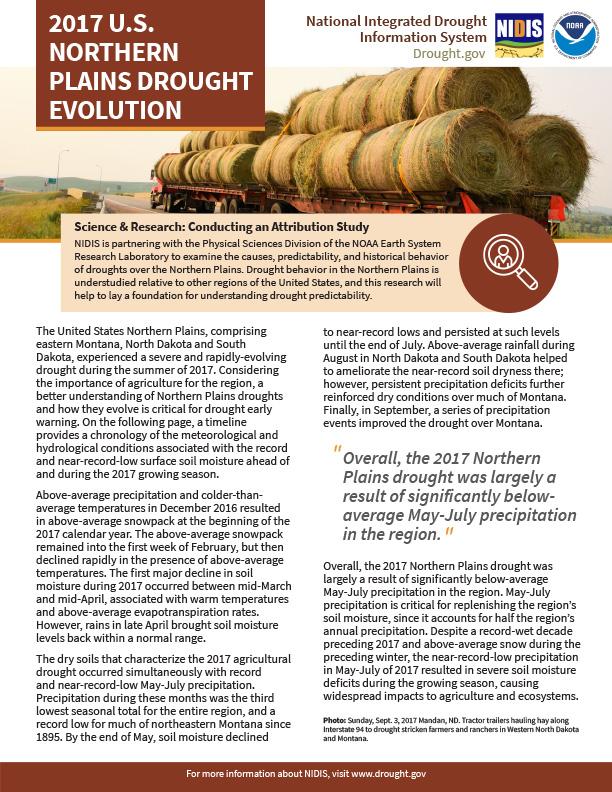For the latest forecasts and critical weather information, visit weather.gov.
2017 U.S. Northern Plains Drought Evolution
The United States Northern Plains, comprising eastern Montana, North Dakota and South Dakota, experienced a severe and rapidly-evolving drought during the summer of 2017. Considering the importance of agriculture for the region, a better understanding of Northern Plains droughts and how they evolve is critical for drought early warning. In the document, a timeline provides a chronology of the meteorological and hydrological conditions associated with the record and near-record-low surface soil moisture ahead of and during the 2017 growing season.
Above-average precipitation and colder-than-average temperatures in December 2016 resulted in above-average snowpack at the beginning of the 2017 calendar year. The above-average snowpack remained into the first week of February, but then declined rapidly in the presence of above-average temperatures. The first major decline in soil moisture during 2017 occurred between mid-March and mid-April, associated with warm temperatures and above-average evapotranspiration rates. However, rains in late April brought soil moisture levels back within a normal range.
The dry soils that characterize the 2017 agricultural drought occurred simultaneously with record and near-record-low May-July precipitation. Precipitation during these months was the third lowest seasonal total for the entire region, and a record low for much of northeastern Montana since 1895. By the end of May, soil moisture declined to near-record lows and persisted at such levels until the end of July. Above-average rainfall during August in North Dakota and South Dakota helped to ameliorate the near-record soil dryness there; however, persistent precipitation deficits further reinforced dry conditions over much of Montana. Finally, in September, a series of precipitation events improved the drought over Montana.
Overall, the 2017 Northern Plains drought was largely a result of significantly below-average May-July precipitation in the region. May-July precipitation is critical for replenishing the region’s soil moisture, since it accounts for half the region’s annual precipitation. Despite a record-wet decade preceding 2017 and above-average snow during the preceding winter, the near-record-low precipitation in May-July of 2017 resulted in severe soil moisture deficits during the growing season, causing widespread impacts to agriculture and ecosystems.
Data and Methods
Precipitation is based on the 5km analysis of NOAA/NCEI1. 10-m wind speed is based upon the ERA-interim reanalysis2. 10-cm soil moisture, evapotranspiration and snow water equivalent are based on the Noah 2.8 model driven by National Land Data Assimilation System version 2 (NLDAS-2)3 meteorological forcing. The soil moisture time series was obtained by averaging over the region bounded by 45-49˚N, 100-109˚W. While it represents a large section of the Northern Plains region, some locations may have experienced more or less extreme conditions than what is depicted.


